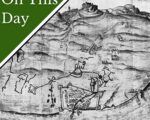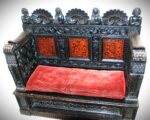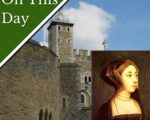
-
Monday Martyr – The Dryburn Martyrs

-
May 7 – An English assault on Leith

On this day in Tudor history, 7th May 1560, in the reign of Elizabeth I, English troops charged the wall of Leith at the siege of Leith.
In 1548, during the War of the Rough Wooing, which had broken out over Scotland’s refusal to marry Mary Queen of Scots off to Edward VI, Scotland had invited French troops to protect the port of Leith. They set up a garrison and were still there 12 years later. Protestant reformers turned to England to help them remove these French Catholics.
[Read More...] -
May 6 – Edmund Beaufort is executed

For today’s “on this day” event, I’m taking you back to the Wars of the Roses. It’s a relevant event because it was a factor in Henry Tudor (Henry VII) becoming the main Lancastrian claimant.
On this day in history, 6th May 1471, Edmund Beaufort, styled 3rd Duke of Somerset, was executed in Tewkesbury marketplace following his army’s defeat at the Battle of Tewkesbury. He was buried at Tewkesbury Abbey
[Read More...] -
May 5 – Sir Henry Sidney

On this day in Tudor history, 5th May 1586, in the reign of Queen Elizabeth I, fifty-six-year-old Sir Henry Sidney died. His body was buried in the Sidney Chapel at Penshurst and his heart in Ludlow, where he lived as President of the Council in the Marches of Wales.
[Read More...] -
From the archives – Help finding Tudor Primary Sources

There’s nothing like researching Tudor primary sources for yourself and a lot have been transcribed and digitised, making it possible to access them from the comfort of your own home.
Here on the Tudor Society, we have lists of primary sources for each monarch as well as different topics, such as Tudor Life.
[Read More...] -
An update on the bench with links to Catherine of Aragon

-
May 4 – Bess of Hardwick

On this day in history, 4th May 1608, the funeral of Elizabeth Talbot, Countess of Shrewsbury, took place at All Hallows, Derby.
Bess of Hardwick as she is commonly known, was the daughter of John Hardwick and Elizabeth Leake.
[Read More...]
She married four times and each marriage saw her rise in status and wealth. Her husbands were heir to an estate Robert Barley or Barlowe, Treasurer of the King’s Chamber Sir William Cavendish, Captain of the Guard and Chief Butler of England Sir William St Loe, and George Talbot, 6th Earl of Shrewsbury. -
May 3 – Cecily Neville, mother of two kings

On this day in history, 3rd May 1415, Cecily Neville, Duchess of York, was born on 3rd May 1415 at Raby Castle. Cecily is known as the matriarch of the House of York because her children included King Edward IV and King Richard III.
Here are some facts about Cecily Neville, also known as the Rose of Raby and Proud Cis.
[Read More...] -
May 2 – Queen Anne Boleyn is arrested

On this day in Tudor history, 2nd May 1536, Queen Anne Boleyn, second wife of King Henry VIII, received a message informing her that members of the king’s council required her presence in the council chamber of Greenwich Palace. There, Anne was told that she was being accused of having sexual relations with musician Mark Smeaton, groom of the stool Henry Norris and an unnamed man. She was also told that Smeaton and Norris had confessed.
Anne denied the charges but the council ordered her arrest. Later that afternoon, after the tide had turned, she was rowed to the Tower of London. She was imprisoned in the queen’s apartments of the royal palace.
George Boleyn, Lord Rochford, Anne’s brother, was arrested on the same day and also taken to the Tower.
[Read More...] -
May 1 – May Day

Happy May Day!
Yes, today, 1st May is May Day in the UK.
May Day was seen as the first day of summer and had its roots in ancient celebrations of fertility. It was celebrated with special processions, plays and pantomimes, pageants, Morris dancing and the crowning of a May Queen. There would also be a Maypole, a tall wooden pole that was painted or decorated with crests, greenery and flowers. Later in history, this Maypole was hung with ribbons and people would dance around it, weaving the ribbons in different patterns.
People would also “bring in the May”, i.e. collect flowers and branches to make garlands and wreaths.
[Read More...]
